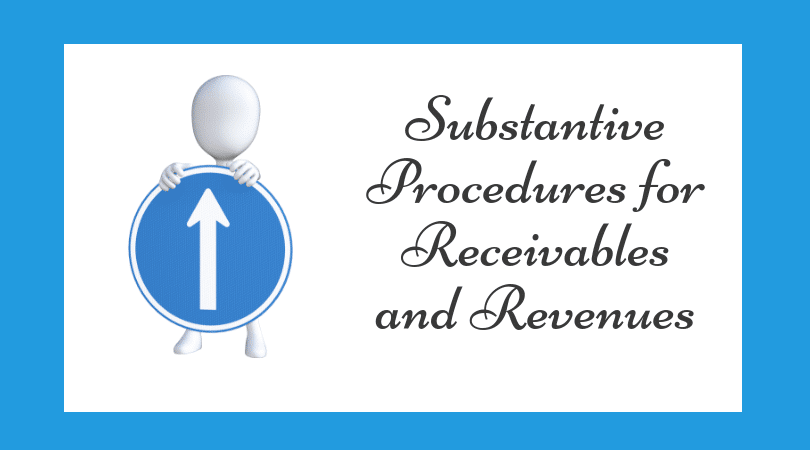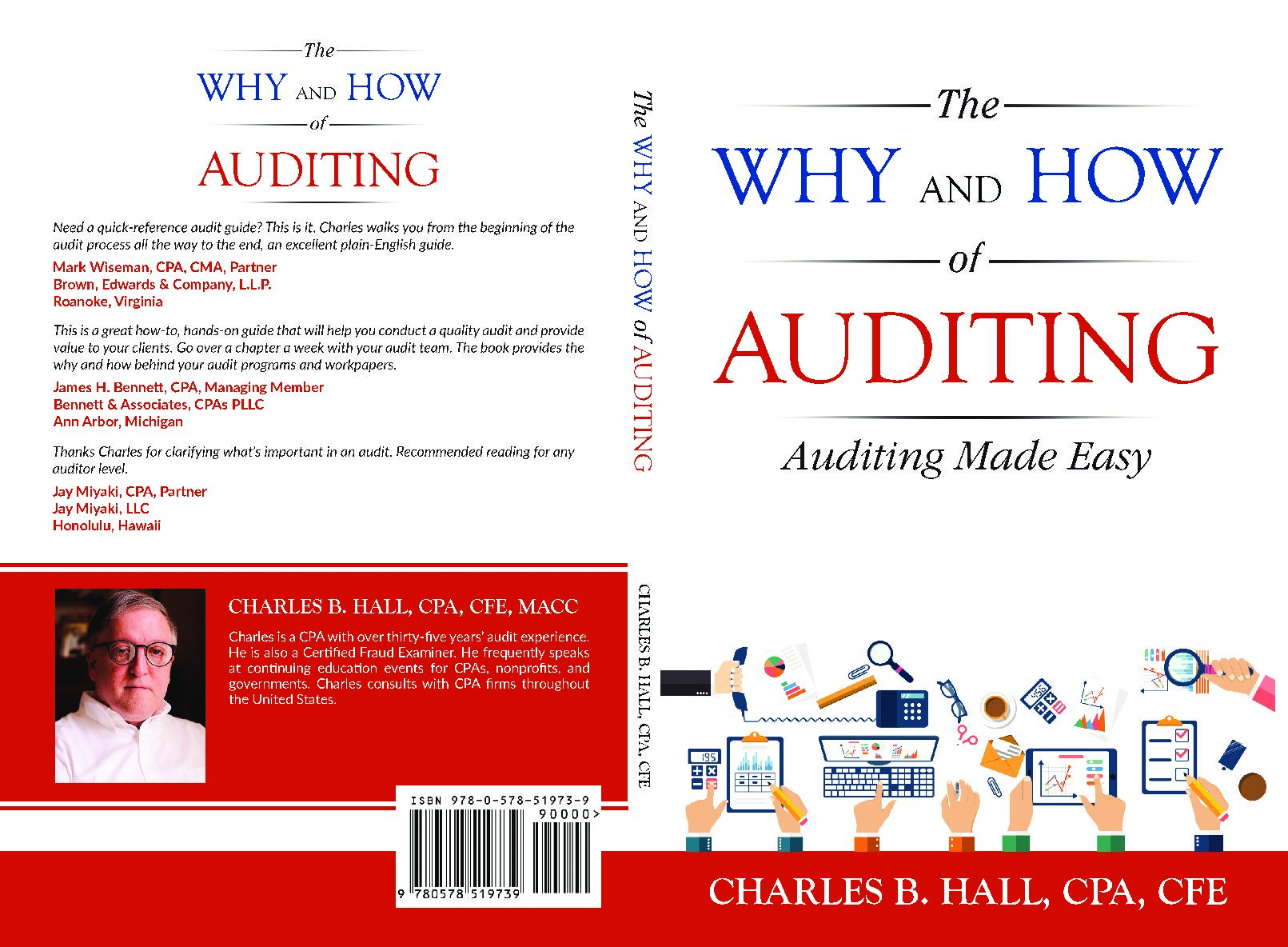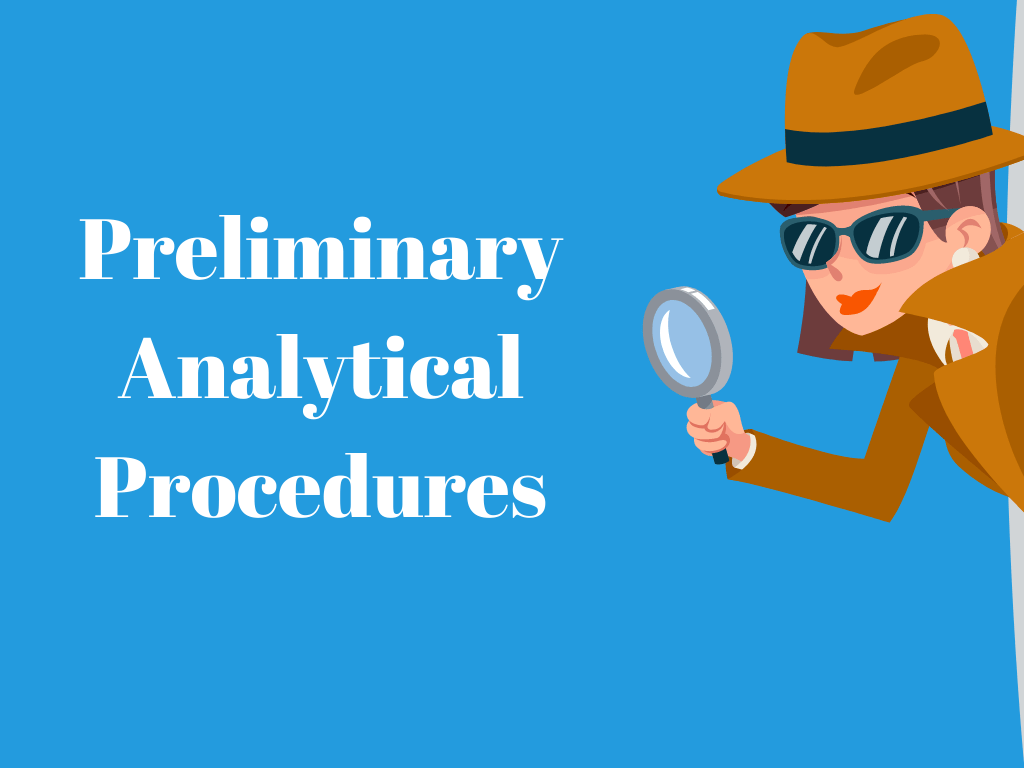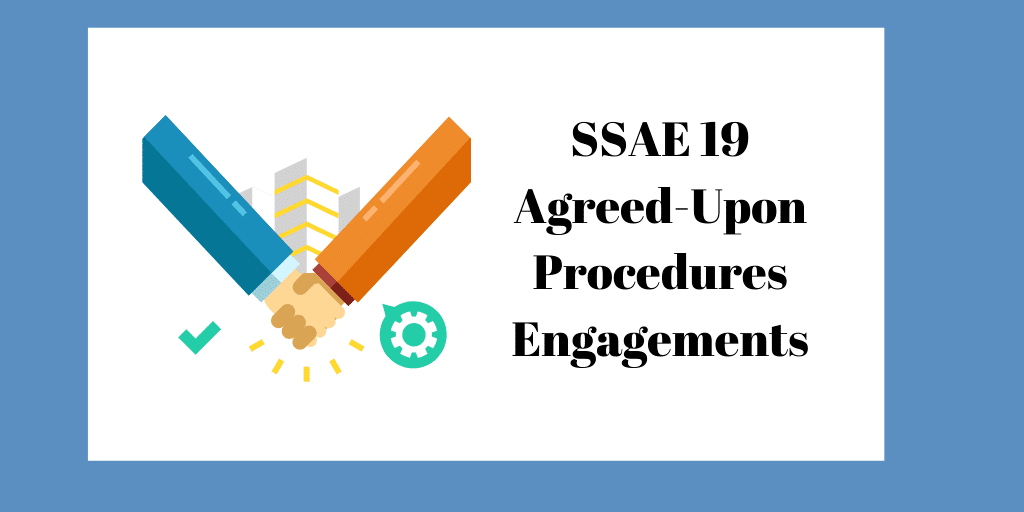Should Companies Perform Retrospective Review of Accounting Estimates

Auditing Investments: A Guide
By Charles Hall | Auditing
Auditing investments is important, peculiarly when an auditee has big balances. Below I provide a comprehensive look at how you can audit investments effectively and efficiently.
The complexity of auditing investments varies. For entities with simple investment instruments, auditing is piece of cake. Your principal inspect procedure might be to ostend balances. Complex investments, however, require boosted work such equally auditing values. As investment complication increases, so will your need for stronger audit team members (those that understand unusual investments). Regardless, you demand an audit methodology.

How to Inspect Investments
In this post, we will accept a look at:
- Primary investment assertions
- Investment walkthroughs
- Directional risk for investments
- Primary risks for investments
- Common investment control deficiencies
- Risk of material misstatement for investments
- Substantive procedures for investments
- Common investment work papers
Master Investments Assertions
First, let's wait at assertions.
Primary relevant assertions for investments include:
- Beingness
- Accurateness
- Valuation
- Cutoff
The audit client is asserting that the investment balances exist, that they are accurate and properly valued, and that but investment activeness inside the period is recorded.
While investment balances in the financial statements are of import, disclosures are likewise vital, especially when the entity owns complex instruments.
Investment Walkthroughs
Second, perform your hazard cess work in light of the relevant assertions.
As you lot perform walkthroughs of investments, you commonly look for ways that investments might be overstated (though investments can exist understated as well). You are asking, "What can go incorrect?" whether intentionally or by error. You want to know if:
- The controls were appropriately designed, and
- The controls were implemented (in utilize)
Walkthrough Questions
In performing investment walkthroughs, ask questions such as:
- What types of investments are owned?
- Are there whatsoever unusual investments? If yes, how are they valued?
- Is a specialist used to determine investment values?
- Who determines the nomenclature of investments (e.1000., trading, available for sale, held to maturity) and how
- Practise the persons accounting for investment activity have sufficient cognition to do so?
- Are timely investment reconciliations performed by competent personnel?
- Are all investment accounts reconciled (from the investment statements to the full general ledger)?
- Who reconciles the investment accounts and when?
- Are the reconciliations reviewed by a 2nd person?
- Are all investment accounts on the general ledger?
- How does the entity ensure that all investment action is included in the general ledger (appropriate cutoff)?
- Who has the power to transfer investment funds and what are the related controls?
- Is in that location appropriate segregation of duties for:
- Persons that record investments,
- Persons that buy and sell investments, and
- Persons that reconcile the investment statements
- What investment accounts were opened in the period?
- What investment accounts were closed in the menstruum?
- Who has the authority to open or close investment accounts?
- Are there any investment restrictions (externally or internally)?
- What persons are authorized to purchase and sell investments?
- Does the entity have a written investment policy?
- Does the company use an investment counselor? If yeah, how often does direction interact with the advisor? How are investment fees adamant?
- Are there any investment impairments?
- Who is responsible for investment disclosures and do they have sufficient knowledge to carry out this duty?
- Are at that place whatsoever price or equity-method investments?
Every bit we ask questions, we also inspect documents (e.g., investment statements) and make observations (e.m., who reconciles the investment statements to the general ledger?).
If control weaknesses exist, we create audit procedures to address them. For example, if during the walkthrough nosotros note that there are improperly classified investments, then will program audit procedures to address that risk.
Directional Gamble for Investments
Tertiary, consider the directional adventure of investments.
The directional risk for investments is that they are overstated. And then, in performing your audit procedures, perform procedures to ensure that balances are properly stated.
Principal Risks for Investments
Quaternary, recollect near the risks related to investments.

Primary risks include:
- Investments are stolen
- Investments are intentionally overstated to cover up theft
- Investments accounts are intentionally omitted from the general ledger
- Investments are misstated due to errors in the investment reconciliations
- Investments are improperly valued due to their complexity and direction's lack of bookkeeping knowledge
- Investments are misstated due to improper cutoff
- Investment disclosures are not accurate or complete
Common Investment Control Deficiencies
Fifth, think about control deficiencies noted during your walkthroughs and other risk assessment piece of work.
Information technology is common to have the post-obit investment control deficiencies:
- One person buys and sells investments, records those transactions, and reconciles the investment activity
- The person overseeing investment accounting does not possess sufficient noesis or skill to properly perform the duty
- Investment reconciliations are not performed timely or improperly
- The visitor does not utilise sufficient aid in valuing complex avails such as hedges or culling investments
Take a chance of Material Misstatement for Investments
6th, now its time to assess your risks.
In my smaller audit engagements, I usually assess control risk at high for each assertion. (Yous may, however, assess command chance at less than high, provided your walkthrough reveals that controls are appropriately designed and that they were implemented. If control risk is assessed at below high, you must test controls for effectiveness to support the lower take a chance cess.)
When control chance is assessed at high, inherent risk becomes the driver of the risk of material misstatement (control risk Ten inherent take a chance = hazard of textile misstatement). For example, if control risk is high and inherent risk is moderate, and so my RMM is moderate.
Important Assertions
The assertions that concern me the about are existence, accurateness, valuation, and cutoff.
The assertions that concern me the well-nigh are existence, accuracy, valuation, and cutoff. So my RMM for these assertions is usually moderate to high.
My response to higher risk assessments is to perform certain substantive procedures: namely, confirming investments, testing investment reconciliations, testing values, and vetting investment disclosures.
Substantive Procedures for Investments
And finally, it'due south time to decide your substantive procedures in light of your identified risks.
My customary audit tests include:
- Confirming investment balances agreeing them to the general ledger
- Inspecting menstruum-end action for proper cutoff
- Using an investment specialist to value complex instruments (if whatsoever)
- Vetting investment disclosures with a electric current disclosure checklist
I don't normally test controls related to investments. If controls are tested and you determine they are constructive, so some of the substantive procedures may non be necessary.
Common Investment Work Papers
My investments piece of work papers usually include the post-obit:
- An agreement of investment-related internal controls
- Take chances assessment of investments at the exclamation level
- Documentation of any control deficiencies
- Investment audit program
- Investment reconciliations
- Investment confirmations
- Valuations performed by specialists
- Documentation of the specialist's experience, competence, and objectivity
- Disclosure checklist
Auditing Investments - A Uncomplicated Summary
- The primary relevant investment assertions include beingness, accurateness, valuation, and cutoff
- Perform a walkthrough of investments by making inquiries, inspecting documents, and making observations
- The directional risk for investments is an overstatement
- Primary risks for investments include:
- Investments are stolen
- Investments are intentionally overstated to cover up theft
- Investments accounts are intentionally omitted from the general ledger
- Investments are misstated due to errors in the investment reconciliations
- Investments are improperly valued due to their complexity and management's lack of accounting noesis
- Investments are misstated due to improper cutoff
- Investments disclosures are not accurate or complete
- The noun procedures for investments should be responsive to the identified risks; common procedures include:
- Confirming investments
- Inspecting period-end activity for proper cutoff
- Using an investment specialist to value complex instruments
- Vetting investment disclosures with a current disclosure checklist
Now you know how to audit investments.
See my next mail regarding how to audit payables and expenses.
This postal service is a office of my series The Why and How of Auditing. Cheque my other posts.

Auditing Receivables and Revenues: A Guide
By Charles Hall | Auditing
Today we take a look at auditing receivables and revenues.
Revenues are the lifeblood of any organisation. Without cash inflows, the entity may cease to exist. So, it'due south of import that each business generate sales or some type of revenue. For y'all, the accountant, it's important to verify the revenue.
Along with revenues, auditors need to prove receivables. Why? Some companies dispense their earnings by inflating their period-terminate receivables. When trade receivables increase, revenues increase. And so, a company can increase its net income by recording nonexistent receivables.
In this post, nosotros'll reply questions such every bit, "should I confirm receivables or examine subsequent receipts?" and "why should I assume that revenues are overstated?"

How to Inspect Receivables and Revenues — An Overview
In this mail service, we will cover the following:
- Primary accounts receivable and acquirement assertions
- Accounts receivable and revenue walkthrough
- Directional chance for accounts receivable and revenues
- Main risks for accounts receivable and revenues
- Common accounts receivable and acquirement control deficiencies
- Risk of textile misstatement for accounts receivable and revenues
- Substantive procedures for accounts receivable and revenues
- Common accounts receivable and revenue work papers
Primary Assertions
First, permit'south expect at assertions.
The primary relevant accounts receivable and revenue assertions are:
- Existence and occurrence
- Completeness
- Accuracy
- Valuation
- Cutoff
Of these assertions, I believe—in general—being (of receivables), occurrence (of revenues) and valuation (of receivables) are most important. And so, clients assert that:
- Receivables be
- Receivables are properly valued, and
- Revenues occurred
Accuracy comes into play if the customer has complex receivable transactions. Additionally, the cutoff exclamation is ofttimes relevant, especially if the client has incentives to inflate the receivables residuum (eastward.g., bonuses triggered at certain income levels).
When auditing receivables and revenues, consider these assertions.
Accounts Receivable and Acquirement Walkthrough
Second, think about performing your take a chance assessment work in light of the relevant assertions.
As nosotros perform walkthroughs of accounts receivable and revenue, we are looking for ways they are overstated (though they can also exist understated equally well). Nosotros are asking, "What tin can go wrong, whether intentionally or by mistake?"
In performing accounts receivable and revenue walkthroughs, ask questions such equally:
- Are receivables subsidiary ledgers reconciled to the general ledger?
- Is a consistent allowance methodology used?
- What method is used to compute the allowance and is it reasonable?
- Who records and approves the allowance?
- Who reviews anile receivables?
- What controls ensure that revenues are recorded in the correct period?
- Is there adequate segregation of duties between persons recording, billing, and collecting payments? Who reconciles the related records?
- What software is used to track billings and collections?
- Are there whatsoever decentralized drove locations?
- When are revenues recognized and is the recognition in accord with the reporting framework?
- What receivables and revenue reports are provided to the owners or the governing body?
As we ask questions, we also inspect documents (due east.g., aged receivable reports) and brand observations (e.thousand., who collects the payments?).
If controls weaknesses exist, we create audit procedures to respond to them. For example, if—during the walkthrough—we run into inconsistent allowance methods, we will perform more substantive work to prove the allowance balances.
Directional Gamble for Accounts Receivable and Revenues
Third, consider directional adventure when auditing receivables and revenues.

The directional hazard for accounts receivable and acquirement is an overstatement. And then, in performing your inspect procedures, perform procedures to ensure that accounts receivables and revenues are not overstated. For example, review the cutoff procedures at period-end. Be sure that no subsequent period revenues are recorded in the electric current fiscal year.
Audit standards require that auditors review estimates for direction bias. And then, consider the current year assart and bad debt write-offs in light of the prior year allowance. This retrospective review allows the auditor to run across if the current estimate is fair. The threat is that management might reduce allowances to inflate earnings.
Moreover, the audit standards state in that location is a presumption (unless rebutted) that revenues are overstated. Therefore, we are to presume revenues are overstated, unless nosotros can explain why they are non.
Primary Risks for Accounts Receivable and Revenues
Fourth, think about the risks related to receivables and revenues.
The main risks are:
- The company intentionally overstates accounts receivable and revenue
- Company employees steal collections
- Without proper cutoff, an overstatement of accounts receivables and revenue occurs
- Allowances are understated
- Revenue recognition
Risks related to revenue also vary from company to company. For instance, one telecommunications company might sell bundled services while some other may not. Revenue recognition is more complex (risky) for the company selling arranged services.
Too, revenue risks vary from manufacture to industry. For example, the allowance for uncollectible is normally a high take a chance area for healthcare entities, but may not exist so for other industries.
Common Accounts Receivable and Revenue Control Deficiencies
Fifth, retrieve about the command deficiencies noted during your walkthroughs and other risk assessment piece of work.
In smaller entities, the following control deficiencies are mutual:
- 1 person performs i or more than of the post-obit:
- bills customers
- receipts monies
- makes deposits
- records those payments in the general ledger
- reconciles the related bank business relationship
- The person computing allowances doesn't possess sufficient knowledge to do and so correctly
- No surprise audits of receivables and revenues
- Multiple people work from one cash drawer
- Receipts are not accordingly issued
- Receipts are not reconciled to daily collections
- Daily receipts are not reviewed by a 2d person
- No i reconciles subsidiary receivable ledgers to the general ledger
- Individuals with the power to adapt customer receivable accounts (with no second-person approval or review) also collect cash
- Inconsistent bad debt recognition with no second-person review process
- The revenue recognition policy may non be clear and may not exist in accordance with the reporting framework
Chance of Cloth Misstatement for Accounts Receivable and Revenues
6th, at present information technology'southward time to assess your risks .
In smaller engagements, I normally assess control risk at high for each exclamation. Controls must be tested to support any lower control gamble assessments. Assessing risks at loftier is often more efficient than testing controls.
When command take chances is assessed at high, inherent chance becomes the commuter of the risk of fabric misstatement (inherent risk X control take chances = take a chance of material misstatement). The assertions that concern me the about (those with higher inherent risks) are being, occurrence, and valuation. So my RMM for these assertions is commonly moderate to loftier.
My response to college risk assessments is to perform certain substantive procedures: namely, receivable confirmations and tests of subsequent collections. As RMM increases, I transport more confirmations and examine more than subsequent collections.
Additionally, I thoroughly examination management'southward allowance computation. I pay particular attention to uncollected amounts beyond 90 days. Uncollected amounts beyond 90 days should commonly be heavily reserved. And amounts across 120 days should—mostly—be fully reserved.
Substantive Procedures
And finally, it'due south time to decide your substantive procedures in light of your identified risks.

My customary audit procedures when auditing receivables and revenues are equally follows:
- Confirm accounts receivable balances (especially larger amounts)
- Vouch subsequent period collections, making sure the subsequent collections relate to the period-end balances (sampling can be used)
- Thoroughly review allowance computations to see if they are consistent with prior years; compare allowance percentages to industry averages; agree to supporting documentation (e.g., histories of uncollectible amounts); recompute the related numbers
- Create comparative summaries of all significant revenue accounts, comparing the current year amounts with historical data (iii or more years if possible)
- Create summaries of average per client income and compare with prior years (y'all may want to do this by specific revenue categories)
- Compute average turn a profit margins by sales categories and compare with previous years
Additionally, I add together extended procedures to my inspect program if there are high risks of cloth misstatement such as pregnant risks. For instance, if a company sells bundled goods, I test how the company apportions the acquirement recognition. Or if at that place are no segregation of duties, I add fraud-related procedures such as testing daily cash collections. The boosted procedures accost the root of the identified risks.
Common Work Papers
My accounts receivable and revenue work papers frequently include the following:
- An understanding of accounts receivable and revenue-related internal controls
- Risk assessment of accounts receivable and revenue at the exclamation level
- Documentation of any control deficiencies
- Accounts receivable and acquirement inspect program
- A item of receivables comprising amounts on the general ledger
- Copies of confirmations sent
- A summary of confirmations received
- Subsequent collections work papers
- Allowance piece of work paper
- Revenue comparison work papers
In Summary
In this chapter, we've looked at the following for receivables and revenues:
- How to perform hazard assessment procedures,
- Relevant assertions,
- Risk assessments (as a result of the gamble assessment procedures), and
- Substantive procedures
Next, we'll see how to audit investments.
Get Your Re-create of The Why and the How of Auditing
Click the book comprehend beneath to run across the book on Amazon.

Get your copy on Amazon; click the book paradigm.

Auditing Cash: The Why and How Guide
By Charles Hall | Auditing
Auditing greenbacks tends to be straightforward. Nosotros usually just obtain the banking company reconciliations and test them. Nosotros ship confirmations and vouch the outstanding reconciling items to the subsequent month'south bank statement. But are such procedures e'er adequate? Hardly.
Retrieve the Parmalat and ZZZZ Best Carpet Cleaning frauds. In those businesses, the theft of cash was covered up with faux depository financial institution statements and fake confirmation responses. Millions were lost and reputations we're sullied.

How to Audit Greenbacks
In this mail service, we volition take a await auditing cash including:
- Primary cash assertions
- Cash walkthrough
- Directional take chances for cash
- Primary risks for cash
- Common cash command deficiencies
- Risk of material misstatement for greenbacks
- Substantive procedures for greenbacks
- Common cash work papers
Chief Cash Assertions
The chief relevant greenbacks assertions are:
- Existence
- Abyss
- Rights
- Accurateness
- Cutoff
Of these assertions, I believe beingness, accuracy, and cutoff are near of import. The audit client is asserting that the cash residue exists, that information technology'southward accurate, and that only transactions inside the period are included.
Nomenclature is commonly not a relevant exclamation. Cash is near always a current asset. Only when banking concern overdrafts occur, classification tin can be in play. The negative cash balance can be presented equally cash or as a payable depending on the circumstances.
Cash Walkthrough
As nosotros perform walkthroughs of greenbacks, we normally look for ways that greenbacks might exist overstated (though it tin also exist understated besides). We are asking, "What tin go wrong?" whether intentionally or by mistake.
In performing cash walkthroughs, ask questions such as:
- Are timely bank reconciliations performed by competent personnel?
- Are all depository financial institution accounts reconciled?
- Are the bank reconciliations reviewed by a second person?
- Are all depository financial institution accounts on the general ledger?
- Are transactions accordingly cut off at catamenia-end (with no subsequent catamenia transactions appearing in the electric current year)?
- Is there appropriate segregation betwixt persons treatment cash, recording cash, making payments, and reconciling the bank statements
- What banking concern accounts were opened in the menstruum?
- What depository financial institution accounts were closed in the menstruum?
- Are there any restrictions on the depository financial institution accounts?
- What persons are on the bank signature cards?
- Who has the authorization to open and/or shut banking company accounts?
- What is the nature of each bank business relationship (e.g., payroll bank account)?
- Are there any cash equivalents (e.g., investments of less than iii months)
- Were there any held checks (checks written but unreleased) at menstruation-cease?
Equally we ask questions, we besides audit documents (due east.thousand., bank reconciliations) and brand observations (who is doing what?).
If controls weaknesses exist, we create inspect procedures to accost them. For instance, if during the walkthrough we review three monthly bank reconciliations and they all have obvious errors, we will perform more than substantive piece of work to prove the year-end bank reconciliation. For example, we might vouch every outstanding deposit and disbursement.
Directional Risk for Cash
What is directional risk in auditing greenbacks? It'south the potential bias that a client has regarding an account residue. A customer might want an overstatement of avails and an understatement of liabilities since each makes the balance sheet appear healthier.
The directional chance for greenbacks is overstatement. So, in performing your audit procedures, perform procedures such as testing the bank reconciliation to ensure that cash is not overstated.
Primary Risks for Greenbacks
The primary risks are:
- Cash is stolen
- Cash is intentionally overstated to embrace upwardly theft
- Not all greenbacks accounts are on the full general ledger
- Cash is misstated due to errors in the banking concern reconciliation
- Cash is misstated due to improper cutoff
Common Greenbacks Control Deficiencies
In smaller entities, it is mutual to have the following command deficiencies:
- Ane person receipts and/or disburses monies, records those transactions in the general ledger, and reconciles the related bank accounts
- The person performing the banking company reconciliation does not possess the skill to perform the duty
- Bank reconciliations are non timely performed
Risk of Material Misstatement for Cash
In my smaller audit engagements, I usually assess control risk at loftier for each exclamation. If control run a risk is assessed at less than high, then controls must be tested to support the lower risk assessment. Assessing risks at loftier is unremarkably more than efficient than testing controls.
When control risk is assessed at loftier, inherent chance becomes the driver of the take a chance of fabric misstatement (control risk X inherent chance = gamble of material misstatement). For case, if control risk is high and inherent risk is moderate, then my RMM is moderate.
The assertions that concern me the most are being, accuracy, and cutoff. So my RMM for these assertions is unremarkably moderate to high.
My response to higher risk assessments is to perform certain substantive procedures: namely, bank confirmations and testing of the depository financial institution reconciliations. As RMM increases I examine more of the period-end depository financial institution reconciliations and more than of the outstanding reconciling items. Too, I am more inclined confirm the balances.
Noun Procedures for Cash
My customary audit tests are every bit follows:
- Ostend cash balances
- Vouch reconciling items to the subsequent calendar month's bank statement
- Ask if all bank accounts are included on the general ledger
- Inspect last deposits and disbursements for proper cutoff
The accountant should send confirmations directly to the bank. Some individuals create simulated bank statements to cover up theft. Those aforementioned persons provide fake confirmation addresses. And then the confirmation is sent to an individual (the fraudster) rather than a bank. Once received, the fraudster replies to the confirmation as though the bank is doing so. You lot can lessen the chance of fraudulent confirmations by using Confirmation.com, a company that specializes in banking company confirmations. Alternatively, you might Google the confirmation address to verify its being.
Agree the confirmed bank balance to the flow-end bank reconciliation (e.1000., Dec 31, 20X7). And so, agree the reconciling items on the bank reconciliation to the depository financial institution argument subsequent to the period-end. For instance, examine the January 20X8 bank statement action when immigration the Dec 20X7 reconciling items. Finally, agree the reconciled rest to the general ledger cash balance for the period-end (e.g., Dec 31, 20X7).
Cut-off bank statements (eastward.chiliad., Jan 20, 20X8 bank statement) may be used to examination the outstanding items. Such statements, like to bank confirmations, are mailed directly to the auditor. Alternatively, the accountant might examine the reconciling items by viewing online bank statements. (Read-just rights can be given to the auditor.)
Common Cash Work Papers
My cash work papers unremarkably include the following:
- An understanding of cash-related internal controls
- Take a chance assessment of cash assertions at the assertion level
- Documentation of any control deficiencies
- Cash inspect program
- Banking company reconciliations for each pregnant account
- Depository financial institution confirmations
Auditing Greenbacks
Nosotros've discussed how to perform cash adventure assessment procedures, the relevant cash assertions, the cash risk assessments, and substantive cash procedures.
Next we'll examine how to audit receivables and revenues.
Go Your Re-create of The Why and How of Auditing
Click the book below to see it on Amazon.

Click the book cover to run into The Why and How of Auditing on Amazon.

Preliminary Analytical Procedures
Past Charles Hall | Auditing
Preliminary belittling procedures are used to identify material misstatements in financial statements. In this article, I explicate how to create planning analytics and how to apply them to identify potential misstatements. I also provide documentation tips.

Preliminary Analytical Procedures
The auditing standards provide four hazard cess procedures:
- Inquiry
- Observation
- Inspection
- Analytical procedures
I previously provided you with information most the get-go three run a risk assessment procedures. Today, I provide you with the fourth, analytical procedures.
While analytical procedures should occur at the beginning and the end of an audit, this post focuses on preliminary analytical procedures (sometimes called a preliminary analytical review).
Below I provide the quickest and all-time way to develop audit planning analytics.
What are Analytics?
If you're not an auditor, you lot may exist wondering, "what are analytics?" Call up of analytics as the use of numbers to decide reasonableness. For example, if a company's greenbacks remainder at December 31, 2020, was $100 1000000, is it reasonable for the account to be $5 meg at December 31, 2021? Comparisons such equally this i aid auditors in their search for errors and fraud.
Preliminary Analytical Procedures Overview
We'll cover the following:
- The purpose of preliminary belittling procedures
- When to create planning analytics (at what phase of the audit)
- Developing expectations
- The all-time types of planning analytics
- How to document preliminary belittling procedures
- Developing conclusions
- Linkage to the inspect plan
(The following video comes from my Inspect Risk Assessment Made Easy YouTube playlist. These videos represent to my book of the same name. Run into it on Amazon.)
Purpose of Preliminary Belittling Procedures
Analytical procedures used in planning an audit should focus on identifying risks of fabric misstatement. Your goal every bit an auditor is to return an opinion regarding the fairness of the financial statements. And so, like a good sleuth, you are surveying the accounting mural to see if cloth misstatements exist.
A detective investigates a law-breaking scene using various tools: fingerprints, forensic tests, interviews, timelines. Auditors have their own tools: inquiry, observation, inspection, analytical procedures. Sherlock Holmes looks for the culprit. The auditor (and I know this isn't every bit sexy) looks for material misstatements.
The detective and the auditor are both looking for the same matter: prove. And the deft use of tools can lead to success. A primal instrument (procedure) bachelor to auditors is preliminary analytical procedures.
When to Create Planning Analytics
Create your preliminary analytics after gaining an understanding of the entity. Why? Context determines reasonableness of numbers. And without context (your understanding of the entity), changes in numbers from one twelvemonth to the next may non look like a cerise flag--though perchance they should.
Therefore, learn about the entity first. Are there competitive pressures? What are the visitor'southward objectives? Are there cash menses issues? What is the normal turn a profit margin per centum? Does the organization accept debt? Context creates meaning.
Additionally, create your comparisons of numbers prior to creating your run a risk assessments. Subsequently all, the purpose of the belittling comparisons is to identify risk.
But earlier creating your planning analytics, you showtime demand to know what to wait.
Developing Expectations
Knowing what to expect provides a basis for agreement the changes in numbers from year to year.
Expectations can include:
- Increases in numbers
- Subtract in numbers
- Stable numbers (no significant change)
In other words, you lot can accept reasons to believe payroll (for example) will increment or decrease. Or you might anticipate that salaries will remain like to last year.
Examples of Expectations Not Met
Do y'all look sales to decrease 5% based on decreases in the concluding two years? If yeah, then an increase of 15% is a flashing light.
Or peradventure y'all look sales to remain most the same as last year? Then a 19% increase might be an indication of financial statement fraud.
But where does an auditor obtain expectations?
Sources of Expectations
Expectations of changes can come from (for example):
- By changes in numbers
- Discussions with management about current year operations
- Reading the company minutes
- Staffing reductions
- Not-financial statistics (e.m., decrease the number of widgets sold)
- A major structure project
While you'll seldom know nigh all potential changes (and that's non the goal), information--such as that above--will help you intuit whether change (or a lack of change) in an account residual is a chance indicator.
Now, let's discuss the best types of planning analytics.
The Best Types of Planning Analytics
Auditing standards don't specify what types of planning analytics to apply. Merely some, in my stance, are meliorate than others.Here's my suggested arroyo (for most engagements).

Comparative Numbers
First, create your planning analytics at the fiscal argument reporting level. Why? Well, that's what the financial statement reader sees. And then, why not apply this level (if you can)? (There is one exception in regard to revenues. Run into Analytics for Fraudulent Revenue Recognition below.)
The purpose of planning analytics is to ferret out unexpected alter. Using more than granular information (e.g., trial balance) muddies the h2o. Why? In that location's too much information. You lot might have three hundred accounts in the trial remainder and merely fifty at the financial statement level. Chasing downwardly trial-balance-level changes can be a waste product of time. At least, that'southward the manner I look at it.
Comparative Ratios
2nd, add any key industry ratios tracked past direction and those charged with governance. Frequently, you include these numbers in your leave conference with the board (maybe in a slide presentation). If those ratios are important at the stop of an audit, and so they're probably important in the offset.
Examples of key industry ratios include:
- Inventory turnover
- Render on equity
- Days cash on hand
- Gross profit
- Debt/Equity
Other Metrics
Other metrics such equally earnings before interest, taxes, depreciation, and amortization (EBITDA) are consequential for some companies. If relevant, include those.
Hence, create planning analytics that marshal with the company'southward focal points. And how exercise yous know what those are? Read the company'due south minutes before you create your preliminary analytics. Well-nigh of the fourth dimension you lot'll see the tracked numbers there.
I terminal thought virtually analytical types. When relevant, utilize nonfinancial data, such as the number of products sold. If a company sells just three or four products and yous have the sales statistics, why not compute the estimated revenue and compare it to the recorded revenue? It makes sense to do so. After all, the auditing standards say that preliminary analytics may include both financial and nonfinancial information.
Okay, then we know what analytics to create, but how should we certificate them?
Analytics for Fraudulent Revenue Recognition
AU-C 240 says the auditor should include preliminary analytics relating to revenue accounts.
AU-C 240 suggests a more detailed course of analytics for revenues such as:
- a comparing of sales book with product chapters
- a trend assay of revenues by month and sales returns by month
- a trend analysis of sales by month compared with units shipped to customers
In calorie-free of these suggested procedures, it may be prudent to create revenue analytics at a more granular level than that shown in the financial statements.
How to Certificate Preliminary Planning Analytics
Here are my suggestions for documenting preliminary planning analytics.
- Certificate overall expectations.
- Include comparisons of prior-twelvemonth/current-year numbers at the financial statement level. (You might likewise include multiple prior yr comparisons if you accept that information.)
- Certificate central industry ratio comparisons.
- Summarize your conclusions. Are there indicators of increased risks of material misstatement? Is yep, say so. If no, say so.
Once you create your conclusions, place whatever identified risks on your summary risk cess work newspaper (where you assess chance at the transaction level--e.one thousand., inventory).
Employ Filtered Analytical Reports with Caution (if at all)
Some auditors employ filtered trial balance reports for their analytics. For example, all accounts with changes of greater than $30,000. There is a danger in using such thresholds.
What if you lot wait a modify in sales of 20% (approximately $200,000) merely your filters include:
- all accounts with changes greater than $50,000, and
- all accounts with changes of more than than xv%
If sales remain abiding, then this risk of material misstatement (you expected alter of xx%, only it did not happen) fails to announced in the filtered report. The filters remove the sales account because the change was minimal. At present, the run a risk may go undetected.
Developing Conclusions
I am a laic in documenting conclusions on central work papers . So, how do I develop those conclusions? And what does a decision await like on a planning analytics piece of work newspaper?
Starting time, develop your conclusions. How? Browse the comparisons of prior year/current year numbers and ratios. We employ our expectations to make judgments concerning the ceremoniousness of changes and of numbers that remain stable. Call up this is a judgment, so, there's no formula for this.
No Risk Identified
Now, y'all'll certificate your conclusions. Merely what if there are no unexpected changes? You expected the numbers to move in the fashion they did. So no identified risk is present. Your conclusion volition read, (for instance):
Conclusion: I reviewed the changes in the accounts and noted no unexpected changes. Based on the planning analytics, no risks of material misstatement were noted.
Adventure Identified
Alternatively, you lot might see unexpected changes. You idea sure numbers would remain constant, just they moved significantly. Or you expected textile changes to occur, merely they did not. Again, document your conclusion. For instance:
Conclusion: I expected payroll to remain constant since the company's workforce stayed at approximately 425 people. Payroll expenses increased, however, by 15% (almost $3.8 million). I am placing this run a risk of cloth misstatement on the summary take a chance assessment work paper at 0360 and volition create audit steps to address the risk.
Now, information technology's fourth dimension to place the identified risks (if in that location are whatever) on your summary risk cess form.
Linkage to the Audit Plan
I summarize all risks of material misstatements on my summary risk assessment course. These risks might come from walkthroughs, planning analytics or other hazard assessment procedures. Regardless, I want all of the identified risks--those discovered in the take a chance assessment procedure--in 1 place.
The final stride in the audit risk cess process is to link your identified risks to your audit plan.
Overview of Risk Assessment and Linkage
Now, I tailor my audit program to address the risks. Tailoring the audit program to answer to identified risks is known as linkage.
Audit standards call for the following risk cess process:
- Take chances assessment procedures (e.g., planning analytics)
- Identification of the risks of material misstatement
- Creation of audit steps to respond to the identified risks (linkage)
Summary of Preliminary Belittling Procedure Considerations
And then, at present you know how to use planning analytics to search for risks of cloth misstatement--and how this powerful tool impacts your audit plan.
Allow's summarize what nosotros've covered:
- Planning analytics are created for the purpose of identifying risks of material misstatement
- Develop your expectations before creating your planning analytics (acquire about the entity's operations and objectives; review past changes in numbers for context--bold you've performed the audit in prior years)
- Create analytics at the fiscal statement level, if possible
- Use key industry ratios
- Conclude virtually whether risks of material misstatement are present
- Link your identified risks of material misstatement to your audit program
So there you lot are. I hope you've establish this commodity useful. For more information about adventure assessment, bank check out my book Audit Risk Assessment Fabricated Easy, available on Amazon.
First-Year Businesses and Planning Analytics
You may be wondering, "merely what if I my customer is new?" New entities don't have prior numbers. Then, how can yous create planning analytics?
First Option
One option is to compute expected numbers using non-financial data. So compare the calculated numbers to the general ledger to search for unexpected variances.
Second Option
A 2d selection is to calculate ratios common to the entity'south industry and compare the results to industry benchmarks.
While industry analytics can be computed, I'm not sure how useful they are for a new company. An infant company often does not generate numbers comparable to more mature entities. Merely we'll proceed this choice in our quiver--just in example.
Third Option
A more useful pick is the third: comparing intraperiod numbers.
D iscuss the expected monthly or quarterly revenue trends with the client earlier you examine the accounting records. The warehouse foreman might say, "Nosotros shipped well-nigh nil the first vi months. Then things defenseless fire. My caput was spinning the last one-half of the year." Does the full general ledger reflect this story? Did revenues and costs of goods sold significantly increase in the latter half of the twelvemonth?
Fourth Choice
The last option we've listed is a review of the monetary comparisons. Some entities, such as governments, lend themselves to this alternative. Others, not and so–those that don't adopt budgets.
Summary
So, yes, it is possible to create useful take a chance assessment analytics–fifty-fifty for a first-year company.

SSAE 19: Agreed-Upon Procedures Engagements
By Charles Hall | Auditing
On December 19, 2019, the AICPA released SSAE 19, Agreed-Upon Procedures Engagements. AUPs provide you with the power to provide balls in a targeted manner (eastward.g., but for inventory). Though y'all've been able to perform AUPs for many years, the new guidance in SSAE 19 provides you with greater flexibility. See how below.
Greater AUP Flexibility
CPAs will find the new agreed-upon procedures (AUP) standard (SSAE nineteen) more flexible that the preceding guidance (SSAE 18 AT-C section 215).
How is it more flexible?
- You no longer request an exclamation from the responsible party
- You can issue general-use reports
- Intended users are non required to take responsibility for the sufficiency of the procedures
- Y'all tin develop or assist in developing the procedures over the form of the date
And which of these practise I like the best? No requirement for assertions.
Additionally, I like the option to develop AUP procedures as the engagement progresses. In the by, the client might review the draft AUP study (at the stop of the engagement) and realize it doesn't come across their needs. Sometimes information technology's meliorate for practitioners to develop procedures as they perform the AUP. SSAE 19 allows you to do just that.
So, if you develop new procedures, what must you lot do? Prior to issuance of the AUP study, obtain the engaging political party'due south understanding regarding the procedures. Moreover, obtain their acknowledgement that the procedures are appropriate and that they satisfy the intended purpose of the engagement. In event, the customer reviews the procedures, agrees with them, and expresses satisfaction.
Definition of an Agreed-Upon Procedures Date
SSAE 19 defines an agreed-upon procedures appointment as "an testament engagement in which a practitioner performs specific procedures on subject field affair and reports the findings without providing an stance or determination. The bailiwick matter may be financial or nonfinancial data." The standard goes on to say "Because the needs of engaging party may vary widely, the nature, timing, and extend of the procedures may vary, as well."

Now, let's see what the AUP objectives are.
SSAE nineteen Objectives
The objectives of an SSAE 19 date include:
- Applying specific procedures to bailiwick thing
- Issuing a written practitioner's report that describes the procedures applied and the findings
Next, let's look at the structure of an AUP report.
AUP Written report Structure
The structure of the AUP report should be every bit follows:
- Procedures
- Findings
So, the CPA should state what was washed and so provide the findings (results). The procedures and findings are placed in the body of the AUP report.
The description of the procedures should exist uncomplicated and articulate.
Good AUP Procedure and Finding
Here'southward an example of a expert AUP process and finding:
Procedure - We obtained the January 2022 bank check register and the Jan operating banking concern business relationship statement. We compared check numbers 2850, 2892, 2933, 2935, 2972 to cleared checks agreeing the payee and the amount.
Findings - No exceptions were noted.
At present, let's wait at a poor case:
Poor AUP Process and Finding
Process - We scanned the company'south 2022 banking company statements and talked with the CFO. The books seemed to be in gild with the exception of July errors.
Finding - Overall, the bank check disbursements appear to be okay subsequently our general review.
In this poor example, nosotros run into general words or statements. What does the wordscanned mean? How aboutseemed to be in order? Additionally, the finding is vague: okay after our full general review.
SSAE xix provides examples of adequate and unacceptable diction.
Adequate and Unacceptable AUP Diction
SSAE 19 calls the practitioner to clearly ascertain procedures. Moreover, the standard states that practitioners should not perform procedures that are open up to varying interpretations or that are vague.
Unacceptable Terms
.A27 of the standard even provides examples of unacceptable AUP terms such equally:
- Full general review
- Evaluate
- Examine
Acceptable Terms
.A27 also provides examples of acceptable AUP terms such as:
- Inspect
- Compare
- Agree
- Recalculate
In addition to proper wording, document your engagement in accordance with SSAE 19.
AUP Documentation
SSAE 19 calls for the post-obit documentation:
- Written understanding with the engaging party regarding the appropriateness of the procedures performed for the intended purpose of the engagement
- The nature, timing, and extent or procedures performed
- The results of the procedures
You lot'll also demand a written engagement letter (run across paragraph .15 of SSAE 19 for an example) and a representation letter of the alphabet (see paragraph .27 of SSAE xix for an case).
So what nigh dating the representation letter? The representation alphabetic character appointment should be the date of the AUP study. Additionally, the representation letter should accost the discipline matter and periods covered by the practitioner's findings.
By now you may be thinking, "Where tin I find AUP report examples?"
SSAE 19 Illustrative AUP Written report
SSAE xix provides iv illustrative AUP reports in its exhibit (meet .A78).
The four instance AUP reports relate to:
- Statement of investment performance statistics
- Cash and accounts receivable
- Claims of creditors
- Procedures specified in regulation
If yous're looking for a template to follow, see example 2. Why? The greenbacks and accounts receivable procedures and findings are splendid. Build procedures and findings similar these and you'll be in skilful shape.
I suggest you lot download SSAE 19 and keep these reports handy.
So, what nigh independence? Is that required?
Attestation Independence
The practitioner has to exist contained in order to perform an AUP.
One exception exists when the practitioner "is required past law or regulation to accept an agreed-upon procedures appointment and written report on the procedures performed and findings obtained."
SSAE xix Effective Date
The constructive date of SSAE 19 is for AUP reports dated on or subsequently July 15, 2021.
Early implementation is permitted.
If third party balls is not needed, consider issuing a consulting report in lieu of an AUP report. Run across my article: AICPA Consulting Standards - The Swiss Army Knife.
Source: https://cpahalltalk.com/
0 Response to "Should Companies Perform Retrospective Review of Accounting Estimates"
Post a Comment